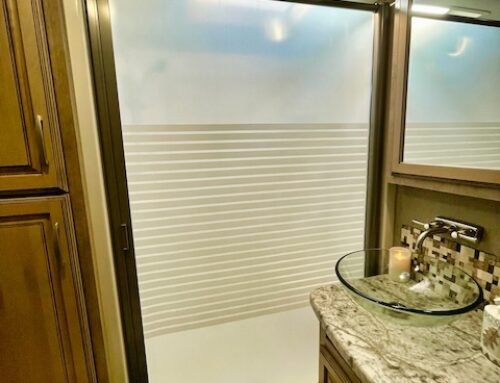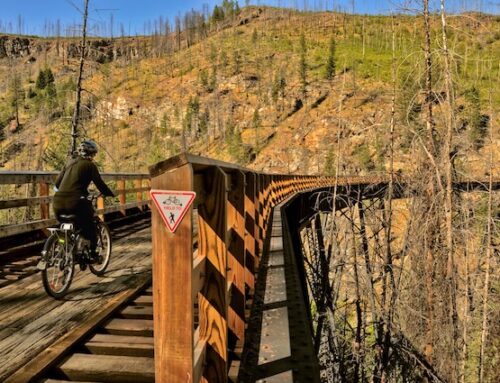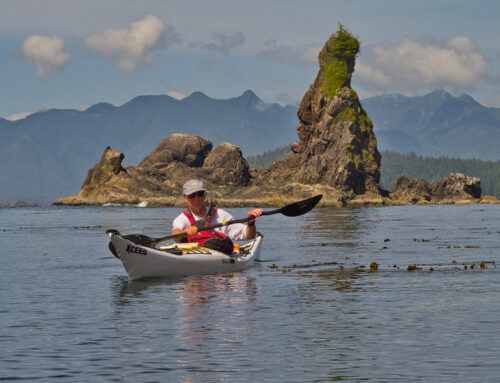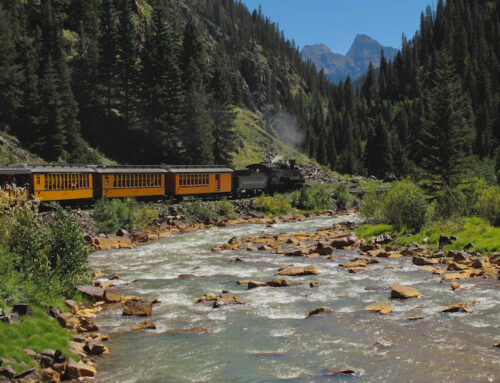Paddling the Yukon River – Whitehorse to the Takhini River
The easiest way to paddle this section of river is to put in right on the Whitehorse water front. There are a couple of ramps there that make launching easy and the water, while moving along at a couple of knots is very placid. If you want a little fun and adventure though, you can put in upstream at the Rotary Centennial pedestrian bridge just below the hydro electric dam.
Put-in at the Rotary Centennial Bridge
Sadly, the big rapids from which Whitehorse derived its name no longer exist thanks to the dam, which created Schwatka Lake and tamed Miles Canyon and the Whitehorse Rapids forever. The water still flows very fast here and there is a small hole very close to shore that has been enhanced with a little help from the Yukon Canoe & Kayak Club. In fact they have a whitewater rodeo here each year in August. They have also constructed a nice little change house up near the parking lot. The put-in is a little gnarly with a steep climb down to the water, but there was a nice big eddy to launch from.
After a little fun playing in the rapids, I moved on downstream to where the paddling club has set up a nice set of whitewater slalom gates. Too bad I’m in my sea kayak! Just above the gates there is a huge circulating eddy creating some really nicely defined whirlpools along the eddyline. Beyond the slalom course the river pretty much flattens out. It is still moving 2 ½ – 3 1/2 knots but there are no longer any standing waves or gnarly eddy lines.
Paddling Past the SS Klondike
One of the first things you pass is the SS Klondike, a fully restored paddle wheeler that plied the waters of the Yukon between Whitehorse and Dawson during the first half of the twentieth century.
The Whitehorse Waterfront
Passing under the bridge to Riverdale, you swing around a corner to the left and are looking at the Whitehorse waterfront on your left. From the low perspective in the water there isn’t a lot to see, but you do pass the old White Pass & Yukon Route train depot. The trains don’t come to Whitehorse any more but you can buy tickets to ride from Carcross, YT or Fraser, BC. See our post on the YP&YR. You may see the bright yellow 1925 Waterfront Trolley roll by using some of the old YP&YR rail, which runs right along the entire Whitehorse waterfront. There are still lots of old pilings along the water front, remainders of the docks left over from the paddle wheeler days.
On to the Takhini River
Once you are past Whitehorse, the river gets more pristine. The waters remain placid, and continue to clip along at 2 – 3 knots, but you no longer see many signs of civilization, less so than on the stretch from the Yukon River Bridge on the Alaska Hwy to Whitehorse.
The river continues to wind its way past huge sand and gravel cliffs, boreal forest and in some places widens out into small lakes. The lighting was very interesting on this day and the river continually took on different colours and hues depending on how you were looking at it and as the light changed.
The Takhini River Bridge Take-out
The trip ends 13 nautical miles from the put-in at the The Takhini River, which enters the Yukon from river left. The Takhini is a good sized river as well and very silty. The take out is about a 100 yards up from the junction where there is a boat ramp right beside the Klondike Hwy bridge. Fortunately there are pretty good eddies so you can paddle upstream to the ramp.




























Leave A Comment